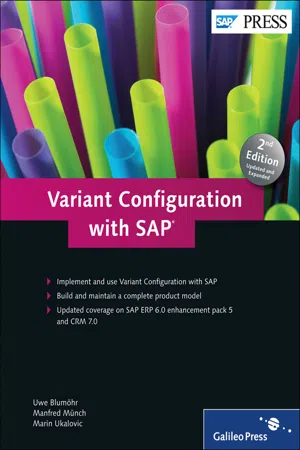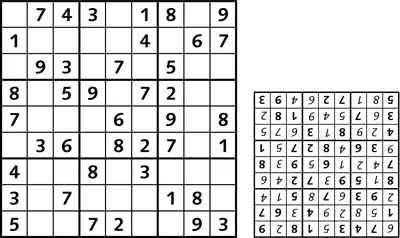
- 694 pages
- English
- ePUB (mobile friendly)
- Available on iOS & Android
Variant Configuration with SAP
About this book
With this all-inclusive reference, you have everything you need to implement, customize, and use Variant Configuration with SAP. Whether you're a consultant, work directly with variant configuration, or are a manager, this book contains essential information you need in order to make key decisions on how Variant Configuration works best for your company. 1. Variant Configuration in ERP and CRM Understand how to integrate Variant Configuration in processes such as quality management and customer service, and explore the necessary Customizing steps. 2. Advanced Integration Topics Find extensive coverage on business processes for SAP ERP, including the Order Engineering Workbench, planning Variant Configuration, and more. 3. Industry-Specific Solutions Learn about unique configurations and enhancements that are possible within specific industries and how to manage them, accompanied by customer examples and practical suggestions. 4. Expert Knowledge Benefit from the authors' and SAP customers' notes on special challenges encountered when implementing and using Variant Configuration for product models. 5. Updated and Expanded This new edition covers integrated Product and Process Engineering (iPPE), Product Data Replication (PDR), the new PLM environment, and much more.
Highlights:
- Product Model (Configuration profile and scenarios)
- Business Processes in SAP ERP (Integrated process and product engineering (iPPE), Integration, Customizing)
- Product Configuration (Variant Configurator LO-VC, Internet Pricing and Configurator (IPC))
- Challenges (Performance optimization, change services, Product Data Replication (PDR))
- Project and Practical Reports
- (Industry solution DIMP reports, project managers, SAP customers and partners, Configuration Workgroup (CWG) and outlook on SAP Business ByDesign)
Frequently asked questions
- Essential is ideal for learners and professionals who enjoy exploring a wide range of subjects. Access the Essential Library with 800,000+ trusted titles and best-sellers across business, personal growth, and the humanities. Includes unlimited reading time and Standard Read Aloud voice.
- Complete: Perfect for advanced learners and researchers needing full, unrestricted access. Unlock 1.4M+ books across hundreds of subjects, including academic and specialized titles. The Complete Plan also includes advanced features like Premium Read Aloud and Research Assistant.
Please note we cannot support devices running on iOS 13 and Android 7 or earlier. Learn more about using the app.
Information
1 Basic Principles of Variant Configuration
1.1 What Is Product Configuration?
1.1.1 Terminology
- Setting parameters of a software system
This enables a purpose-driven use, for example, in the Customizing of the Enterprise Resource Planning solution of SAP (SAP ERP) or in Business Configuration of SAP Business ByDesign. - Calculating the annual income tax
The income statement requires individual specifications as to income and costs. - Concluding automobile third-party insurance
Such a conclusion is based on individual specifications as to the car and the drivers. These specifications determine the insurance contributions and are defined together with the insurance contract. - Purchasing a new car
Prior to purchasing a car, you have to decide on properties such as color and equipment. - Tailoring a custom-made suit
The tailor measures his customers to make perfectly fitting suits. - Maintaining a cable car
Maintenance work generally depends on many factors, such as the operating hours passed, the age, and the operational demand of the object to be maintained. - Project planning for a conference
Among other things, this planning depends on the number of participants expected. - Submitting a road construction measure
Type and length of the road are characterizing factors here. - Supplying an open-plan office with office furniture
Such a supply is associated with a number of dependencies (e.g., for adjacent desks).



Table of contents
- Notes on Usage and on the Screen Presentation
- Table of Contents
- Dear Reader
- Foreword
- Introduction
- 1 Basic Principles of Variant Configuration
- 2 Creating a Product Model for SAP Variant Configuration
- 3 Business Processes in SAP ERP
- 4 Customizing SAP ERP for Variant Configuration
- 5 Special Features of Product Configuration in SAP CRM
- 6 Challenges in Variant Configuration
- 7 Enhancements in SAP Industry Solution DIMP
- 8 Enhancements and Add-Ons in the SAP Partner Environment
- 9 Project Lead Reports on Projects and Project Structures
- 10 Customer Reports on the Introduction of SAP Variant Configuration
- 11 Configuration Workgroup
- 12 Outlook for SAP Business ByDesign
- A Database Tables of Variant Configuration
- B APIs of Variant Configuration
- C User Exits of Variant Configuration
- D Comprehensive Examples of Variant Functions
- E The Authors
- Index
- Service Pages
- Legal Notes